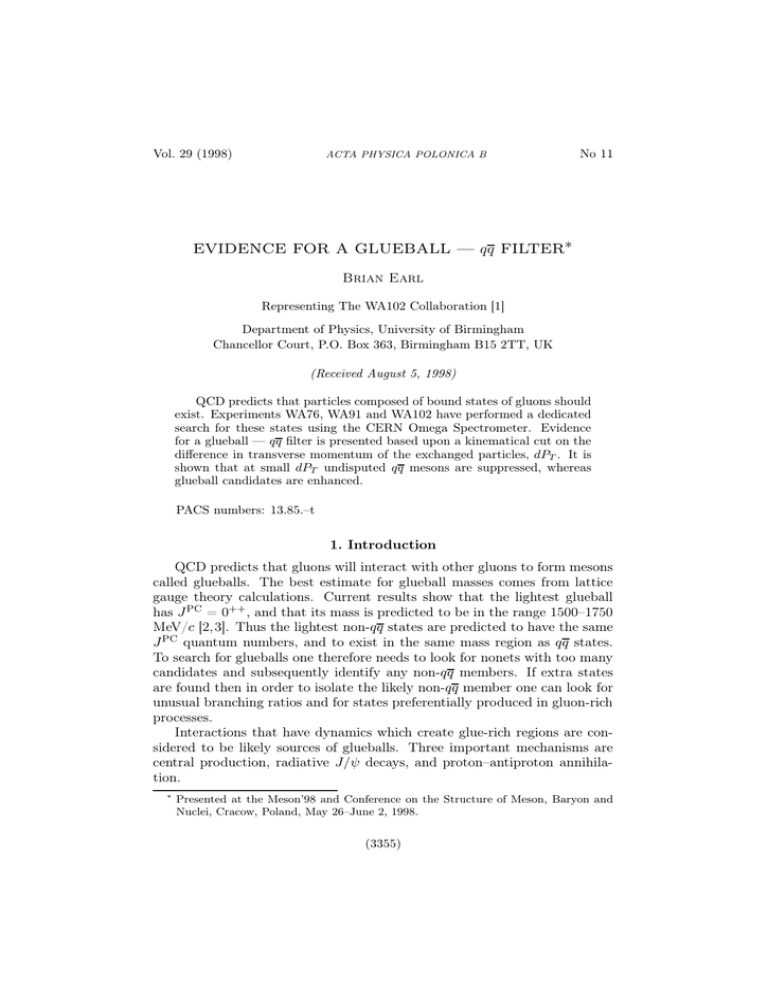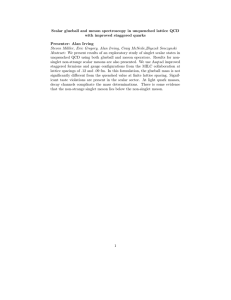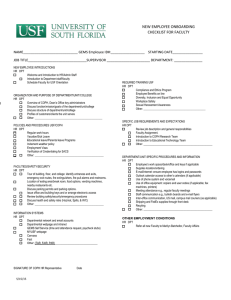EVIDENCE FOR A GLUEBALL — qq FILTER
advertisement

Vol. 29 (1998) ACTA PHYSICA POLONICA B No 11 EVIDENCE FOR A GLUEBALL — qq FILTER∗ Brian Earl Representing The WA102 Collaboration [1] Department of Physics, University of Birmingham Chancellor Court, P.O. Box 363, Birmingham B15 2TT, UK (Received August 5, 1998) QCD predicts that particles composed of bound states of gluons should exist. Experiments WA76, WA91 and WA102 have performed a dedicated search for these states using the CERN Omega Spectrometer. Evidence for a glueball — qq filter is presented based upon a kinematical cut on the difference in transverse momentum of the exchanged particles, dPT . It is shown that at small dPT undisputed qq mesons are suppressed, whereas glueball candidates are enhanced. PACS numbers: 13.85.–t 1. Introduction QCD predicts that gluons will interact with other gluons to form mesons called glueballs. The best estimate for glueball masses comes from lattice gauge theory calculations. Current results show that the lightest glueball has J PC = 0++ , and that its mass is predicted to be in the range 1500–1750 MeV/c [2,3]. Thus the lightest non-qq states are predicted to have the same J PC quantum numbers, and to exist in the same mass region as qq states. To search for glueballs one therefore needs to look for nonets with too many candidates and subsequently identify any non-qq members. If extra states are found then in order to isolate the likely non-qq member one can look for unusual branching ratios and for states preferentially produced in gluon-rich processes. Interactions that have dynamics which create glue-rich regions are considered to be likely sources of glueballs. Three important mechanisms are central production, radiative J/ψ decays, and proton–antiproton annihilation. ∗ Presented at the Meson’98 and Conference on the Structure of Meson, Baryon and Nuclei, Cracow, Poland, May 26–June 2, 1998. (3355) 3356 B. Earl 2. Evidence for a glueball — qq filter in central production The WA102 central production experiment [4] is designed to study exclusive final states formed in the reaction pp −→ pf X 0 ps , where pf and ps refer to the fastest and slowest particles in the laboratory frame respectively, and X 0 represents the central system produced by double exchange. The WA91 collaboration has published a paper [5] showing that the production of resonances depends on the azimuthal angle between the outgoing fast and slow protons. In order to understand this effect further Close and Kirk [6] proposed that the data be analysed in terms of the difference in transverse momentum between the particles exchanged from the fast and slow vertices. The difference in the transverse momentum vectors (dPT ) is defined to be p dPT = (Py1 − Py2 )2 + (Pz1 − Pz2 )2 , where P yi , P zi are the y and z components of the momentum of the ith exchanged particle in the pp centre of mass system. It is observed that the production of undisputed qq states is enhanced clear eect becomes when presented at large dPT and This suppressed at small dPstriking effectasisa seen when T . A remarkable of small dIPT transfer to large dIP T transfer. applying the dPT ratio criteria to channels containing glueball Specically, the points represent the quantitycandidates. At small dPT the glueball candidates are all more prominant than in the total mass spectrum. It is also interesting to note that the enigmatic f0 (980), a dIPT 0 2 possible non-qq meson or KK molecule dIPT state 0 5 does not behave as a normal qq state. : Ratio Ratio Ratio : Fig. 1. Ratio of the number of events for dPT < 0.2 GeV to the number of events for dPT ≥ 0.5 GeV for each resonance considered. Evidence for a Glueball — qq Filter 3357 The acceptance corrected mass spectra in three dPT ranges has been fitted using the resonance parameters calculated from the fit to the total mass spectrum. From these fits the contribution of each resonance to the total as a function of dPT has been found. The ratio of the number of events for dPT < 0.2 GeV to the number of events for dPT ≥ 0.5 GeV for each resonance considered is shown in figure 1. It is seen that the undisputed qq states all have a small value for this ratio. This is in contrast to the glueball candidates f0 (1500), fJ (1710) and f2 (1900), and the states f0 (1300) and f0 (980) which could have a gluonic component, which all have a large value for this ratio. 3. Summary The results presented in this paper give evidence for a kinematical filter which selects glueball candidates from undisputed qq states in central production. All the undisputed qq states are observed to be suppressed at small dPT , but the glueball candidates f0 (1500), fJ (1710), and f2 (1900), together with the enigmatic f0 (980), survive. REFERENCES [1] The WA102 collaboration: D. Barberis, W. Beusch, F.G. Binon, A.M. Blick, F.E. Close, K.M. Danielsen, A.V. Dolgopolov, S.V. Donskov, B.C. Earl, D. Evans, B.R. French, T. Hino, S. Inaba, A.V. Inyakin, T. Ishida, A. Jacholkowski, T. Jacobsen, G.V. Khaustov, T. Kinashi, J.B. Kinson, A. Kirk, W. Klempt, V. Kolosov, A.A. Kondashov, A.A. Lednev, V. Lenti, S. Maljukov, P. Martinengo, I. Minashvili, K. Myklebost, T. Nakagawa, K.L. Norman, J.M. Olsen, J.P. Peigneux, S.A. Polovnikov, V.A. Polyakov, Yu.D. Prokoshkin, V. Romanovsky, H. Rotscheidt, V. Rumyantsev, N. Russakovich, V.D. Samoylenko, A. Semenov, M. Sené, R. Sené, P.M. Shagin, H. Shimizu, A.V. Singovsky, A. Sobol, A. Solovjev, M. Stassinaki, J.P. Stroot, V.P. Sugonyaev, K. Takamatsu, G. Tchlatchidze, T. Tsuru, G. Vassiliadis, M. Venables, O. Villalobos Baillie, M.F. Votruba, Y. Yasu. [2] G. Bali et al., (UKQCD), Phys. Lett. B309, 378 (1993). [3] D. Weingarten, hep-lat/9608070. [4] T.A. Armstrong et al., Nucl. Instrum. Methods A274, 165 (1989); F. Antinori et al., Nuovo Cim. A107, 1857 (1994). [5] D. Barberis et al., Phys. Lett. B388, 853 (1996). [6] F.E. Close, A. Kirk, Phys. Lett. B397, 333 (1997).

